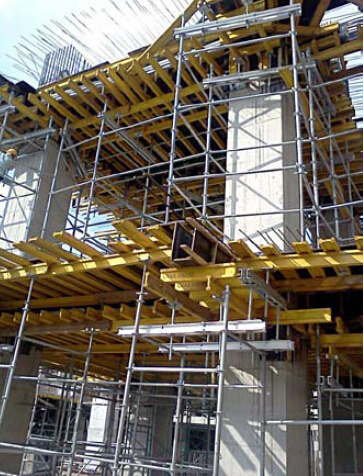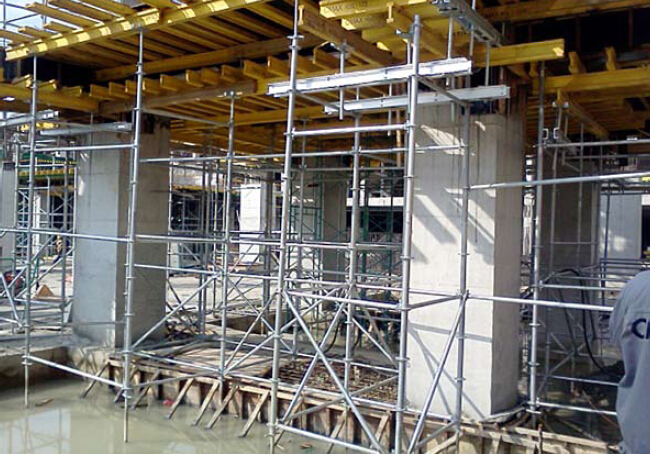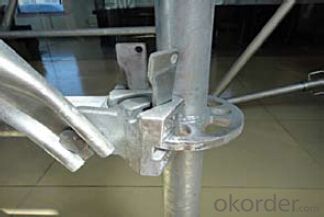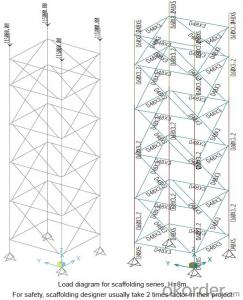Ring-lock Scaffolding Accessories for Formwork and Scaffolding System
- Loading Port:
- Tianjin
- Payment Terms:
- TT OR LC
- Min Order Qty:
- 50 m²
- Supply Capability:
- 1000 m²/month
OKorder Service Pledge
Quality Product, Order Online Tracking, Timely Delivery
OKorder Financial Service
Credit Rating, Credit Services, Credit Purchasing
You Might Also Like
Ring-lock Scaffolding
A support system for construction, ownsadvantages of both cup-lock scaffolding andshoring tower.
It is in the development direction of new typescaffolding.
It is widely used in buildings, bridges, tunnels etc..
Characteristics:
◆ Easy to storage and transportation
◆ High degree of standardization
◆ Easy and quick erection
◆ Excellent stability and bearing capacity


- Q: How does steel formwork contribute to the overall speed of construction?
- Steel formwork contributes to the overall speed of construction by providing a durable and reusable solution for creating concrete structures. The use of steel formwork allows for faster and more efficient construction processes as it can be easily assembled and disassembled, reducing the time required for formwork installation and removal. Additionally, steel formwork provides a smooth and consistent surface, resulting in faster curing times and improved productivity.
- Q: What are the common safety precautions when working with steel formwork?
- When working with steel formwork, there are several common safety precautions that should be followed to ensure the safety of workers and prevent accidents. These precautions include: 1. Proper training: All workers involved in using steel formwork should receive proper training on its assembly, disassembly, and use. This training should cover all safety procedures and precautions. 2. Personal protective equipment (PPE): Workers should always wear appropriate PPE, including safety helmets, safety glasses, hearing protection, gloves, and steel-toed boots. This will protect them from potential hazards such as falling objects, flying debris, and sharp edges. 3. Inspection of formwork: Before starting any work, the steel formwork should be inspected for any defects, damage, or wear. Any damaged or faulty components should be repaired or replaced immediately to ensure structural integrity and prevent accidents. 4. Secure footing: Workers should always have a secure footing when working with steel formwork. This can be achieved by using proper scaffolding, ladders, or working platforms. Additionally, any slippery surfaces should be addressed by using non-slip materials or applying anti-slip coatings. 5. Fall protection: Adequate fall protection measures should be in place, especially when working at heights. This can include using guardrails, safety nets, or personal fall arrest systems (PFAS) to prevent falls and protect workers in case of an accident. 6. Communication and coordination: Effective communication and coordination between workers is crucial when working with steel formwork. Clear communication of tasks, instructions, and potential hazards can help prevent accidents and ensure a safe working environment. 7. Proper lifting techniques: When handling heavy steel formwork components, workers should use proper lifting techniques to avoid strains, sprains, or other injuries. This includes lifting with the legs and not the back, using mechanical lifting aids when necessary, and seeking assistance for heavy or awkward loads. 8. Fire safety: Steel formwork can be a fire hazard, so it is important to have fire prevention measures in place. This includes ensuring adequate fire extinguishers are available, maintaining clear access to fire exits, and having a designated fire assembly point. By following these common safety precautions, workers can minimize the risk of accidents and injuries when working with steel formwork. It is essential for all workers and supervisors to prioritize safety and remain vigilant throughout the entire construction process.
- Q: What are the different types of supports used in steel formwork installation?
- Steel formwork installation commonly utilizes various types of supports to ensure stability and structural integrity. These supports are crucial for the formwork system, offering the following options: 1. Adjustable Props: These props effectively bear the weight of the formwork system and can be easily adjusted to the desired height. They provide stability during concrete pouring and curing. 2. Scaffolding: Frequently employed in steel formwork installation, scaffolding serves as a stable platform for workers. It allows easy assembly and disassembly, making it highly adaptable to different construction projects. 3. Beams and Girders: These horizontal supports distribute load evenly, preventing excessive deflection or deformation of the steel formwork. 4. Bracing: To maintain stability during concrete pouring and curing, diagonal supports known as bracing prevent lateral movement and secure the formwork in place. 5. Anchors and Tie Rods: Anchors and tie rods secure the formwork system to the existing structure, providing additional support and preventing movement or displacement during concrete pouring. 6. Wall Ties: Wall ties hold the formwork panels together, offering lateral support. Typically made of steel, they withstand concrete pressure during pouring and curing. 7. Wedges and Clamps: Wedges and clamps ensure a secure fit of the formwork panels, preventing concrete leakage during pouring. The appropriate selection of support for steel formwork installation depends on factors like structure size, complexity, load-bearing capacity, and site conditions. It is crucial to carefully consider these factors to ensure a safe and efficient formwork installation process.
- Q: What are the different safety training requirements for steel formwork installation?
- The safety training requirements for installing steel formwork may differ depending on the regulations and guidelines established by various countries and organizations. Nevertheless, here are some typical safety training requirements that are commonly applicable: 1. All workers involved in steel formwork installation must undergo general construction safety training, which covers topics such as recognizing hazards, using personal protective equipment (PPE) correctly, fall protection, and proper lifting techniques. 2. Workers should receive specialized training on the specific techniques and procedures related to steel formwork installation. This training may include learning how to assemble and dismantle formwork properly, securing it to prevent collapse, and ensuring stability during concrete pouring. 3. Workers should be trained on operating any equipment used during steel formwork installation, such as cranes or forklifts, in a safe manner. 4. Workers should receive training on hazard communication, including understanding safety signs and labels, handling hazardous materials, and knowing how to respond to emergencies. 5. It is important for workers to be trained in first aid and CPR techniques to be prepared for any accidents or injuries that may occur during steel formwork installation. 6. If scaffolding is used during the installation process, workers should undergo scaffold safety training to understand how to assemble, use, and dismantle scaffolding safely. 7. Depending on the specific tasks involved in steel formwork installation, workers may need additional job-specific safety training. This could include training on working at heights, using power tools, or working in confined spaces. Employers and workers must comply with the relevant safety regulations and ensure that all necessary training is provided to create a safe working environment during steel formwork installation.
- Q: How does steel formwork prevent concrete honeycombing?
- Steel formwork prevents concrete honeycombing by providing a sturdy and rigid structure that holds the concrete in place during pouring and curing. This prevents the formation of voids or gaps in the concrete, ensuring a solid and uniform surface without any honeycombing.
- Q: What are the different types of finishes available for steel formwork?
- There are several different types of finishes available for steel formwork, each offering unique advantages and characteristics. Some of the most common finishes include: 1. Smooth finish: This is the most basic type of finish, where the steel formwork is left untreated. It provides a clean and smooth surface, making it suitable for applications where a smooth concrete finish is desired. 2. Galvanized finish: Galvanizing involves coating the steel formwork with a layer of zinc to protect it from corrosion. This finish is highly durable and can withstand harsh weather conditions, making it ideal for outdoor applications. 3. Powder-coated finish: Powder coating involves applying a dry powder to the steel formwork and then baking it on. This finish provides a decorative and durable coating that is resistant to chipping, scratching, and fading. It is available in a wide range of colors, allowing for customization. 4. Painted finish: Painting the steel formwork is another common option. It provides protection against corrosion and enhances the aesthetics of the formwork. Different types of paints, such as epoxy or acrylic, can be used depending on the specific requirements of the project. 5. Shot-blasted finish: Shot blasting involves projecting small steel shots onto the surface of the formwork at high velocity. This process removes any impurities, rust, or old coatings, resulting in a clean and textured finish. Shot blasting is commonly used when a rough surface is desired for better adhesion of the concrete. 6. Treated finish: Some steel formwork can be treated with special coatings or chemicals to enhance their properties. For example, anti-stick coatings can be applied to prevent concrete from adhering to the formwork, making it easier to remove after curing. Other treatments may include rust inhibitors or fire-resistant coatings. The choice of finish for steel formwork depends on various factors such as the intended use, environmental conditions, desired aesthetics, and budget. Consulting with a professional or manufacturer can help determine the most suitable finish for a specific project.
- Q: Can steel formwork be customized for specific projects?
- Yes, steel formwork can be customized for specific projects. Steel formwork is a versatile and flexible construction material that can be easily modified to meet the specific requirements of a project. It can be cut, bent, and welded into various shapes and sizes to accommodate different architectural and structural designs. This allows for the creation of unique and intricate concrete structures. Additionally, steel formwork can be easily assembled and dismantled, making it ideal for projects that require frequent changes or adaptations. The modular nature of steel formwork allows for easy reconfiguration and customization, saving time and effort during construction. Moreover, steel formwork can be surface-treated to resist corrosion and increase its durability, ensuring that it can withstand the harsh conditions of different construction sites. This makes it suitable for a wide range of projects, including high-rise buildings, bridges, tunnels, and other complex structures. Overall, steel formwork offers significant flexibility and adaptability, allowing it to be customized and tailored to specific project requirements. Its ability to accommodate various shapes, sizes, and designs makes it an excellent choice for construction projects of all types and scales.
- Q: Are there any specific considerations for using steel formwork in areas with limited space?
- When using steel formwork in areas with limited space, there are several specific factors to consider. Firstly, it is important to carefully select the dimensions of the steel formwork system so that it can fit within the available space. This involves considering the height, width, and depth of the formwork components, as well as any necessary clearances for movement and installation. Secondly, careful planning is needed for the assembly and disassembly of the steel formwork system in order to minimize space requirements. This may involve using smaller formwork panels or modular systems that can be easily transported and maneuvered in tight spaces. Additionally, the order in which the formwork is removed should be considered to ensure there is enough space for workers and equipment to safely access the area. Thirdly, the storage of steel formwork components when not in use should be taken into account. In areas with limited space, it may be necessary to stack the formwork panels vertically or use compact storage solutions to maximize space efficiency. Lastly, the accessibility of the construction site should be considered. In areas with limited space, it may be challenging to transport and deliver the steel formwork components. Therefore, it is important to assess the availability of access roads, parking areas, and equipment staging areas to ensure the safe and efficient delivery of the steel formwork to the construction site. Overall, the use of steel formwork in areas with limited space requires careful planning and consideration of dimensions, assembly, disassembly, storage, and site accessibility. By addressing these specific factors, it is possible to effectively utilize steel formwork systems in tight spaces while ensuring the safety and efficiency of the construction process.
- Q: How does steel formwork handle formwork stripping and demolding?
- Steel formwork is known for its durability and strength, making it an excellent choice for handling formwork stripping and demolding. When it comes to the process of formwork stripping, steel formwork offers several advantages. Firstly, steel formwork is designed with a smooth surface, which allows for easy removal of the hardened concrete once it has cured. This smooth surface reduces the chances of concrete sticking to the formwork, making it easier to strip the formwork without causing any damage to the structure. Secondly, steel formwork is typically constructed with a system of joints and connections that facilitate efficient formwork stripping. These joints and connections are designed to be easily detachable, allowing for quick and straightforward removal of the formwork. This feature is particularly beneficial when working on large-scale construction projects where time is of the essence. Furthermore, steel formwork is highly resistant to deformation and warping, ensuring that the formwork remains in its original shape during the stripping process. This resistance to deformation helps to prevent any distortion or damage to the concrete structure during the demolding phase. In addition, steel formwork offers excellent reusability, which further contributes to its efficiency in handling formwork stripping and demolding. Once the formwork is stripped, it can be cleaned, repaired if necessary, and reused for subsequent concrete casting. This reusability not only saves time and money but also reduces the environmental impact associated with formwork disposal. Overall, steel formwork is designed to handle formwork stripping and demolding with ease. Its smooth surface, detachable joints, resistance to deformation, and reusability make it a reliable and efficient choice for construction projects.
- Q: Can steel formwork be used for projects with high concrete durability demands?
- Yes, steel formwork can be used for projects with high concrete durability demands. Steel formwork is known for its strength, durability, and longevity, making it suitable for demanding construction projects. It can withstand heavy loads and provide the necessary support for the concrete during the curing process. Steel formwork also offers excellent dimensional stability, ensuring the accuracy and consistency of the concrete structure. Additionally, steel formwork can be reused multiple times, reducing waste and project costs. However, it is important to ensure proper maintenance and corrosion protection of the steel formwork to maximize its durability and ensure long-term performance.
Send your message to us
Ring-lock Scaffolding Accessories for Formwork and Scaffolding System
- Loading Port:
- Tianjin
- Payment Terms:
- TT OR LC
- Min Order Qty:
- 50 m²
- Supply Capability:
- 1000 m²/month
OKorder Service Pledge
Quality Product, Order Online Tracking, Timely Delivery
OKorder Financial Service
Credit Rating, Credit Services, Credit Purchasing
Similar products
Hot products
Hot Searches
Related keywords




















